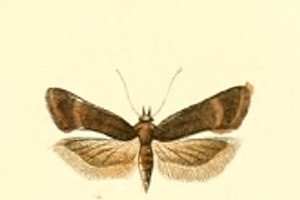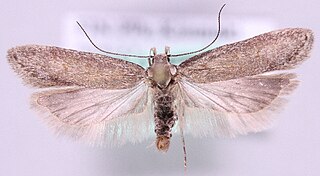
Filatima is a genus of moths in the family Gelechiidae.

Lupinus sericeus is a species of flowering plant in the legume family known by the common name silky lupine or Pursh's silky lupine. It is native to western North America from British Columbia to Arizona and east to Alberta and Colorado.

Filatima spurcella is a moth of the family Gelechiidae. It is found from central and southern Europe to the southern Ural and Turkey.
Filatima transsilvanella is a moth of the family Gelechiidae. It is found in Romania (Transylvania) and Russia.

Filatima incomptella is a moth of the family Gelechiidae. It is found in Scandinavia, the Baltic region, Germany, Poland, European Russia and Siberia (Transbaikal).
Filatima zagulajevi is a moth of the family Gelechiidae. It is found in the European part of southern Russia.
Filatima autocrossa is a moth of the family Gelechiidae. It is found in China, the southern Ural Mountains, the lower Volga region, the Altai Mountains, the Tuva region, the Chita region and the Krasnoyarsk region.
Filatima adamsi is a moth of the family Gelechiidae. It is found in North America, where it has been recorded from Maine.
Filatima ornatifimbriella is a moth of the family Gelechiidae. It is found in North America, where it has been recorded from Colorado, Arizona, Texas, Nebraska and Illinois.
Filatima xanthuris is a moth of the family Gelechiidae. It is found in North America, where it has been recorded from North Carolina, South Carolina, Texas, New Mexico, Arizona, Utah, Nevada, Manitoba, Alberta, British Columbia, Washington and Oregon.
Filatima betulae is a moth of the family Gelechiidae. It is found in North America, where it has been recorded from Massachusetts.
Filatima platyochra is a moth of the family Gelechiidae. It is found in North America, where it has been recorded from California.
Filatima djakovica is a moth of the family Gelechiidae. It is found in southern and central Russia, Ukraine and Romania.
Filatima epulatrix is a moth of the family Gelechiidae. It is found in North America, where it has been recorded from British Columbia, New York, Oklahoma, Ontario and Quebec.
Filatima karsholti is a moth of the family Gelechiidae. It is found in Mongolia and China.
Filatima glycyrhizaeella is a moth of the family Gelechiidae. It is found in North America, where it has been recorded from Washington, Arizona and Colorado.
Filatima loowita is a moth of the family Gelechiidae. It is found in the United States, where it has been recorded from Washington.
Filatima sciocrypta is a moth of the family Gelechiidae. It is found in China.
Filatima revisensis is a moth of the family Gelechiidae. It is found in the United States, where it has been recorded from Illinois, Iowa and Minnesota.
Lupinus garfieldensis, commonly known as the Garfield lupine or the Asotin Silky lupine, is a species of lupine native to eastern Washington state.



